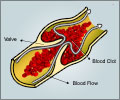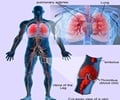A patient admitted for heart failure coughed up a 6-inch wide blood clot, that resembled the right bronchial tree of the lungs.

‘The massive-sized blood clot may have been caused due to an infection that had led to an increased concentration of fibrinogen. Fibrinogen is known to harden the clot, keeping it intact without breaking.’





Georg Wieselthaler, M.D., a transplant and pulmonary surgeon at the University of Florida at San Francisco, and his team traced the patient’s airway passages and identified the origin of the clot to be his right bronchial tree. “It’s a curiosity you can’t imagine — I mean, this is very, very, very rare,” says Wieselthaler. Reasons behind the gross blood clot
In a healthy human body, bronchi in lungs is the abode of gases we breathe in and expel, viz., oxygen and carbondioxide. They branch into smaller bronchioles that bears alveoli, the place where the blood stream drops in carbondioxide and picks up oxygen.
In the case of this patient, there’s much more than air in the bronchi. The doctors fixed a ventricular assist device called impella, into the patient, which helps maintain blood flow. But, the device is known to cause clots in blood, so the doctors gave him an anticoagulant. But the flip-side is, the anticoagulant can prevent coagulation of blood and healing when any tissue gets fissured or broken. In this case, the patient’s blood entered his right bronchial tree, leaving him coughing small clots of blood for many days.
The doctors guess an infection in the patient had caused an increased secretion of fibrinogen, which acts as a ‘glue’ and provided the hardiness that kept the clot intact. Gavitt Woodard, M.D., a clinical fellow at UCSF said “Because it was so large, he was able to generate enough force from an entire right side of his thorax to push this up and out.”
Advertisement















